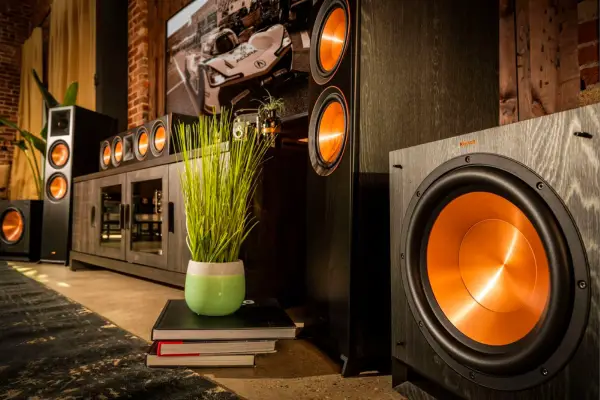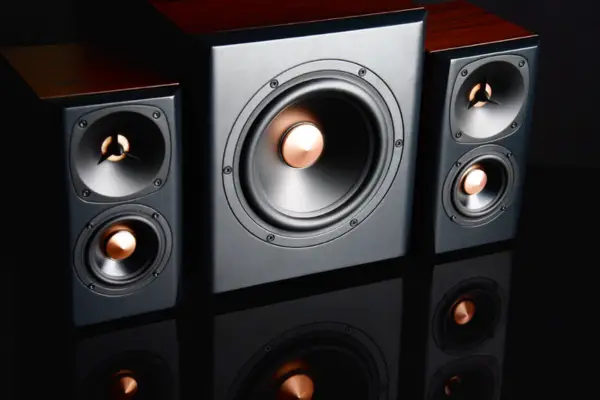Where to Place a Subwoofer – For Home Theater and Vehicles
A potent audio system delivers an immersive and captivating listening experience, and understanding where to place a subwoofer can greatly enhance the overall sound experience, making it crucial to address this often overlooked aspect.
A subwoofer is responsible for delivering the low-frequency sounds or ‘bass’ in an audio setup. While seemingly straightforward, placing a subwoofer optimally is both an art and a science.
The placement can dramatically affect the audio output’s quality, depth, and resonance. This is true not only for the cinematic effects in your home theater but also for the rhythmic thumps in your car audio.
In this article, we’ll guide you through the best practices for subwoofer placement, exploring the specifics for both home theater systems and vehicles.
We’ll shed light on the factors you need to consider, and the techniques you can use, to get the best out of your subwoofer and enhance your audio experience. From room size and shape to the furniture layout and other potential obstacles, numerous aspects contribute to achieving the perfect sound.
So, sit back and get ready to dive deep into the world of low frequencies. Let’s get started.
Basic Understanding of a Subwoofer
Before diving into the specifics of subwoofer placement, it’s essential to understand what a subwoofer is and the significant role it plays in an audio system. A subwoofer is a specialized speaker designed to reproduce low-frequency audio—commonly referred to as ‘bass’—in a sound system.
What is a Subwoofer and What Does It Do?
A subwoofer, often shortened to as a ‘sub’, is designed to reproduce the lowest range of frequencies in an audio system, typically in the range of 20 to 200 Hz for consumer products, a range where general, multi-purpose speakers might lack depth and clarity.
In a home theater setup, a subwoofer brings to life the rumbling lows of a soundtrack, the earth-shattering effects in an action scene, or the subtle, ambient sounds in a quiet, suspense-filled moment. In a vehicle, a subwoofer adds depth and richness to music, letting you feel the rhythm as much as hear it.

Frequency Range of a Subwoofer
Subwoofers are designed to cover the low-end frequency spectrum, which is generally from 20 Hz to 200 Hz for consumer applications. Professional live sound and concert subwoofers can handle frequencies even lower than 20 Hz. The specific frequency range a subwoofer is designed to handle will depend on its size, design, and the specifications set by the manufacturer.
These low frequencies are omnidirectional, meaning they spread out in all directions equally and are less easily absorbed by objects, resulting in a unique set of challenges and considerations when deciding where to place your subwoofer for optimal performance.
Where to Place of a Subwoofer in a Home Theater
Proper placement of a subwoofer within your home theater can significantly enhance the audio experience, creating a much more immersive and cinematic effect. There are several ideal locations to place a subwoofer in a home theater environment, and each of these comes with its unique set of benefits and drawbacks.
Ideal Locations
1. Front of the Room
When you place your subwoofer at the front of the room, ideally between the front left and right speakers, it integrates better with the main speakers. This integration helps in maintaining a more cohesive soundstage, creating the illusion that all sounds are originating from the same direction.
It mirrors the real-world experience of sound coming at you from the front, as if you’re at a live concert or movie theater. But, placing the subwoofer at the front may limit the depth and richness of the bass, especially in larger rooms, as the low-frequency sound waves might not reach every corner effectively.
2. Corner Placement
Placing a subwoofer in a room’s corner can significantly increase its output, thanks to a phenomenon known as room gain or the boundary effect. When the subwoofer is in the corner, sound waves radiate from the corner outwards, effectively using the room as a large amplifier.
The walls and floor act as a passive amplifier for the bass, reinforcing the low frequencies and making them sound louder and fuller. The corner placement can result in an enveloping, immersive bass experience, filling the room more evenly.
Be careful though, because placing your subwoofer in the corner can accentuate certain frequencies, and it might also make the bass sound boomy or less precise.

3. Along the Wall
Subwoofers can also be placed along a wall, usually a few feet from the corner. This positioning provides a sort of middle-ground between the front-of-room and corner placements.
It utilizes the boundary effect to enhance the bass output while mitigating the risk of overly emphasized boomy frequencies that can occur with corner placement.
However, placing a subwoofer along the wall might lead to standing waves, which can create spots in the room where the bass sounds overly loud or too soft. Therefore, careful calibration and possible use of bass traps or room correction software may be needed to balance out the sound.
4. Near-Field Placement
Near-field placement involves positioning the subwoofer close to the listener, often right behind the couch or even under the seating in some cases.
The main benefit of near-field placement is that it can reduce the room’s effect on the bass response, providing a tighter, more controlled low-frequency sound that’s less subject to room modes or standing waves. The bass can feel more immediate and impactful, as the sound has less distance to travel before reaching your ears.
However, the bass experience might become too localized or isolated to the listening spot, making the bass sound less immersive for those seated elsewhere in the room.
Factors to Consider When Choosing Where to Place a Subwoofer at Home
1. Room Size and Shape
The size and shape of your room can significantly impact the sound of your subwoofer. Larger rooms may require more powerful subwoofers or multiple subs to adequately fill the space with sound.
2. Furniture Layout and Other Obstacles
The layout of your furniture, along with any other potential obstacles, can disrupt the flow of sound and create acoustic anomalies. Strategic placement can help circumvent these issues.
3. Soundproofing Considerations
In shared living situations or homes with thin walls, consider soundproofing to prevent bass frequencies seeping out and from traveling to neighboring rooms or homes.

The “Subwoofer Crawl” Technique Explained
The “subwoofer crawl” is a practical method used to determine the optimal placement for a subwoofer in any room. The technique is based on the fact that low-frequency sound waves, which are long and have a wide dispersion pattern, interact significantly with the room’s size, shape, and furnishings, creating areas where the bass sounds louder, softer, or more distorted.
To perform a subwoofer crawl, you begin by placing your subwoofer in or near your primary listening position – on your couch, chair, or wherever you typically sit when listening to your audio system. Then, play some music or audio content featuring a consistent bass line. Now, “crawl” around your room – specifically, listen from different positions at or near the floor level, where the subwoofer would typically be placed.
As you move to various spots, listen carefully to how the bass sounds. You’re looking for a spot where the bass sounds clean and well-balanced, not overly boomy or thin. And, once you’ve identified the optimal location, move your subwoofer there.
Using Multiple Subwoofers
Using multiple subwoofers in your home theater setup can offer several advantages. One of the main benefits is that multiple subs can help to smooth out the bass response in the room. This is because different areas in a room naturally have different bass responses due to the interactions between sound waves and the room’s physical characteristics.
When you use more than one subwoofer, you can place them in different locations to counteract these uneven responses. As a result, you can get a more consistent bass sound across various listening positions. This means that no matter where you sit in your room, the bass quality will be more uniform and less subject to peaks and dips.
Additionally, having multiple subwoofers can provide more power and headroom, enhancing the overall impact and dynamism of the bass. It can also help to reduce distortion, as each subwoofer doesn’t have to work as hard to produce the desired volume levels.
That said, using multiple subwoofers also requires careful calibration and placement to ensure they work together cohesively. It’s often recommended to use identical or closely matched subwoofers to ensure consistent sound characteristics.
Also, be aware that adding more subwoofers doesn’t necessarily mean louder bass, but rather better and more evenly distributed bass.
Placement of a Subwoofer in Vehicles
Knowing where to place a subwoofer in a vehicle requires a different approach than in a home theater. The confined space, presence of passengers, and vehicle’s shape all influence the optimal position of a subwoofer. The goal remains the same – to achieve the best possible bass output and overall audio experience.

Ideal Locations
1. In the Trunk
The trunk is the most common location for a subwoofer in a car. The enclosed space of the trunk essentially acts as a large cabinet for the subwoofer, enhancing its efficiency and boosting the bass output. By positioning the subwoofer in the trunk, you can generally achieve high volume levels and a significant bass presence.
However, this position also presents a few challenges. The biggest one is the potential for sound quality loss when the bass frequencies need to pass through the rear seats and other materials before reaching the cabin.
The type of material and the design of the rear seats can impact the amount of sound that gets through, and in some cases, it may result in a muffled or less defined bass sound.
2. Under the Seat
Another common location for a car’s subwoofer is under the seat. This placement is especially popular in compact cars where space is limited, or in situations where preserving trunk space is a priority.
Positioning a subwoofer under the seat allows the bass to be more direct, minimizing potential sound loss that can occur with trunk placement. The proximity to the listener can also provide a more tactile bass experience, where you not only hear the bass but also feel it.
However, this position requires a compact or shallow-mount subwoofer, and even then, space may be limited. Additionally, under-seat placement may not achieve the same level of volume and depth as a larger subwoofer in the trunk could offer.
3. Rear Parcel Shelf
The rear parcel shelf, located behind the rear seats and beneath the rear windshield, is another viable location for a car subwoofer, particularly in sedan models. This location provides a good balance between efficiency and sound quality.
By placing the subwoofer on the rear parcel shelf, the bass frequencies have a more direct path into the cabin compared to a trunk-mounted subwoofer. And putting your subwoofer here can lead to a clearer, more defined bass sound.
However, installation on the rear parcel shelf can be more complex and may require additional brackets or enclosures for secure mounting. Also, depending on the vehicle’s design, a subwoofer in this position might be more visible and potentially more vulnerable to theft.
Factors to Consider When Choosing Where to Place a Subwoofer in a Vehicle
1. Vehicle Size and Shape
The size and shape of your vehicle will significantly influence your options for subwoofer placement. Larger vehicles like SUVs or vans may accommodate larger subs, while smaller vehicles will likely require more compact solutions.
2. Presence of Passengers and Luggage
How often you have passengers and how much trunk space you typically need for luggage can also affect where you decide to place your subwoofer. You wouldn’t want your audio system to interfere with the practical usage of your car.
3. Soundproofing Considerations
Soundproofing a car can help enhance the quality of your audio system and minimize noise transmission to the outside. This can be crucial if you frequently drive in quiet areas or want to be a good neighbor and you don’t want to disturb others with your music.
Importance of Professional Installation in Vehicles
While it’s possible to install a subwoofer in your vehicle by yourself, professional installation is often recommended. Professionals have the experience and tools to optimize the subwoofer’s performance based on your specific car model and personal listening preferences.
Where to Place a Subwoofer
Knowing where to place a subwoofer can significantly affect the listening experience, whether in a home theater or a vehicle audio setup. Proper placement and fine-tuning of settings can transform the sound quality, making it more immersive and enjoyable.
But there is no set standard for the best placement. As you now know, it depends on a few factors and the entire process is a balance of science, art, and personal preference.
Regardless of the environment, the goal remains the same – achieving the best possible sound. While there are standard guidelines and recommended locations for placement, remember that every room and vehicle is unique, and what works best for one may not work as well for another.
Therefore, always be willing to experiment with the position and settings of your subwoofer until you find what sounds best to you.

I am a passionate and skilled car audio enthusiast with 15 years of experience in the industry. My journey started when I replaced my first set of factory car speakers, sparking a deep love for high-quality sound. Since then, I have worked as a representative for renowned brands like Kenwood and Alpine.
With a background in both retail and distribution, I have developed a comprehensive understanding of the car audio market. Currently a certified (MECP) installer in the Mobile Electronics industry, my expertise lies in delivering top-notch audio installations. My knowledge, coupled with my genuine passion, makes me the go-to professional for all car audio needs.

